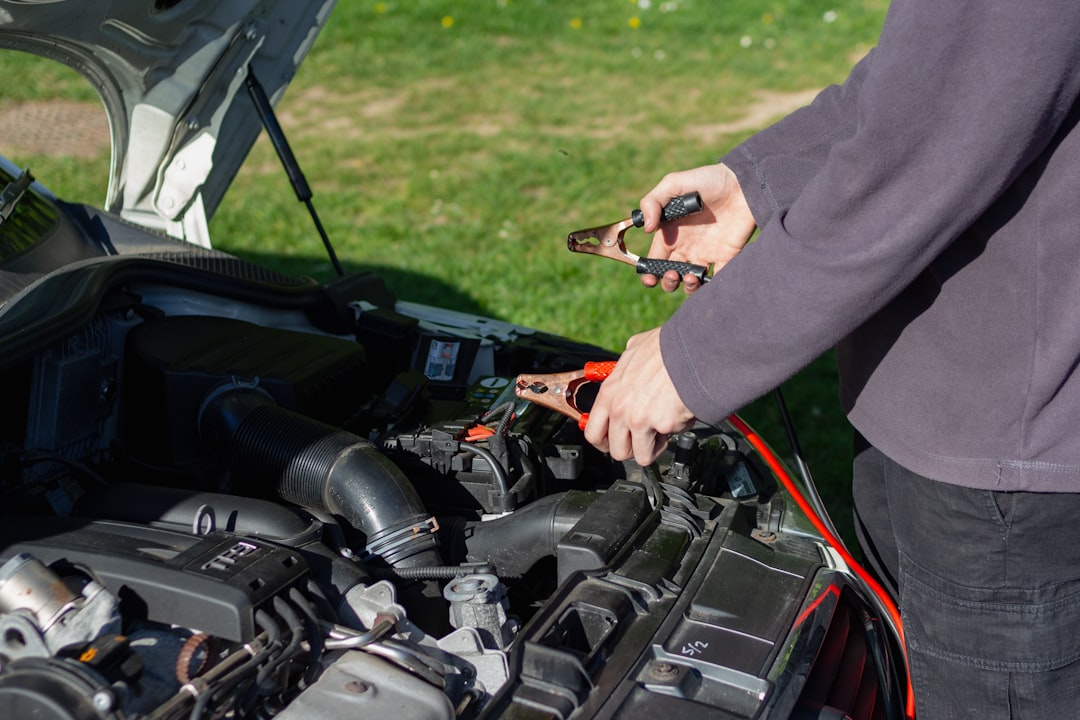Testing a Starter Solenoid: A Step-by-Step Guide

One essential part of a car’s starting system is the starter solenoid. When the ignition key is turned, it is in charge of transferring electrical current from the battery to the starter motor. The engine can crank and start thanks to the solenoid’s function as a switch that engages the pinion gear of the starter motor with the engine’s flywheel. In order to allow current to flow to the starter motor, the solenoid closes a set of contacts in response to an electrical signal received from the ignition key. As soon as the engine starts, the solenoid opens the contacts to stop the starter motor’s current flow and disengages the pinion gear from the flywheel. Usually, the starter solenoid is installed in the engine compartment on the fender well or on the starter motor.
It is a small, cylindrical device with one or two smaller terminals for receiving the electrical signal from the ignition switch and two larger terminals for connecting to the battery and starter motor. When current is applied to the electromagnetic coil in the solenoid, a plunger inside the device is activated. This movement of the plunger completes the circuit to the starter motor. Determining & resolving starting system problems in a car requires an understanding of the operation of the starter solenoid. The vehicle may become unstartable if the solenoid malfunctions and stops the starter motor from getting power.
For a vehicle’s starting system to remain dependable and operational, it is crucial to understand how to test & troubleshoot the starter solenoid. Acquiring the required equipment & supplies ahead of time will help guarantee a seamless & effective diagnostic procedure for the starter solenoid. When testing the starter solenoid, the following supplies and equipment are advised: a multimeter, which is a vital instrument for determining electrical resistance, voltage, and current. It can be used to measure resistance in electrical components, look for voltage drops, & test the continuity of circuits.
To test the starter solenoid, a digital multimeter with probes works best. – Bypass wire: When testing, a bypass wire, also known as a jumper wire, is used to bypass the ignition switch and supply power directly to the starter solenoid. For ease of connection, alligator clips are usually attached to both ends of an insulated wire length. – Safety goggles & gloves: To avoid electrical shock & debris, it’s crucial to wear safety goggles and gloves when working on electrical components. – Owner’s manual: The owner’s manual for your car can provide you important details like where the starter solenoid is located and how to wire it. – Vehicle service manual: Detailed instructions on testing and diagnosing the starter solenoid can be found in a service manual tailored to the make and model of your car. You can make sure you have everything you need to test & diagnose the starter solenoid in your car by gathering these supplies and tools. A vehicle’s starter solenoid is usually found on the starter motor itself or on the engine compartment’s fender well.
| Step | Description |
|---|---|
| 1 | Locate the starter solenoid in the vehicle. |
| 2 | Disconnect the battery to prevent electrical shock. |
| 3 | Use a multimeter to check for continuity between the solenoid terminals. |
| 4 | Test the solenoid for voltage by connecting the multimeter to the solenoid terminals. |
| 5 | Check the solenoid for proper grounding. |
| 6 | Inspect the solenoid for physical damage or wear. |
| 7 | Reconnect the battery and test the starter to see if the solenoid is functioning properly. |
The owner’s manual or service manual for the car will provide precise directions on where to find the starter solenoid. The solenoid is typically mounted to a bracket or directly on the starter motor and located close to the battery or on the fender well. A small wiring harness with one or two smaller terminals connected to it will allow the solenoid mounted on the fender well to receive electrical signals from the ignition switch. Two sizable terminals on the solenoid are also provided for connecting to the starter motor and battery. By mounting the solenoid on the starter motor, it becomes a part of the starter assembly and has terminal connections that are similar.
Look for any indications of corrosion or damage on the starter solenoid after you’ve located it. A vehicle’s inability to start may be caused by loose or corroded connections at the terminals. You can be ready to test and troubleshoot any possible issues with the starting system by becoming familiar with the location and state of the starter solenoid.
A simple procedure that can assist in identifying possible problems with the starting system is to test the starter solenoid using a multimeter. Use these steps to test the solenoid: 1. Ascertain that the multimeter is correctly calibrated & set it to measure resistance (ohms). 2. Cut the wiring harness off of the solenoid’s smaller terminals. Three. Put one of the multimeter’s probes on a smaller terminal and the other on a second, smaller terminal. 4.
When the solenoid coil is operating correctly, the multimeter should show a low resistance reading (usually between 5 & 50 ohms). A malfunctioning solenoid that needs to be replaced is indicated if there is no continuity or an open circuit. 5. After testing, reconnect the wiring harness to the smaller terminals. You can check if the solenoid coil is operating within normal parameters by using a multimeter to measure its resistance.
A malfunctioning solenoid that needs to be replaced may be indicated if the resistance reading is outside of the designated range. The electromagnetic coil that powers the solenoid can have possible problems, which this test can help find. You can use a bypass wire or jumper wire to apply power directly to the starter solenoid in addition to using a multimeter for testing. If power is applied, this test can help determine whether the solenoid can engage and disengage correctly. To use a bypass wire to test the solenoid, do the following: 1. Make sure the parking brake is engaged, the ignition key is off, & the car is in park or neutral. 2.
See which of the solenoid’s two sizable terminals connects to the starter motor and battery. 3. Link the positive terminal of the battery or any other 12-volt power source to one end of the bypass wire and the battery’s terminal to the other. 4. To ground (such as an unpainted metal surface on the vehicle), attach a separate wire from the terminal that connects to the starter motor. 5. An audible click should be heard as the solenoid engages when power is applied through the bypass wire, and the plunger may move as it closes its contacts. 6. As the solenoid disengages, cut off power to the bypass wire and watch for any movement.
The proper engagement and disengagement of the solenoid when power is applied can be tested using a bypass wire. A faulty solenoid that requires replacement may be indicated if there is no movement or audible click when power is applied. If there are any problems with the plunger mechanism or internal contacts inside the solenoid, this test can help determine them. Following a multimeter and bypass wire test on the starter solenoid, it’s critical to analyze the test findings to identify any operational problems.
It is possible that the solenoid is in good working order and does not require replacement if the results of both tests show normal operation within the given parameters. It may be necessary to replace a solenoid if either test reveals anomalous readings or a lack of movement when power is applied. Checking for damage or corrosion in all connections and wiring that lead to the starter solenoid is crucial if testing indicates that it isn’t working properly.
Before replacing the solenoid, it is advisable to fix any loose or corroded connections that may be preventing it from operating properly. Also, look for any obvious wear or damage on the solenoid itself, such as overheating indications or housing cracks. In the event that the starter solenoid needs to be replaced, the vehicle’s service manual will provide detailed instructions for both removal and installation. To guarantee compatibility and appropriate functioning within the starting system, it is crucial to use a replacement solenoid that adheres to the original part’s specifications.
If testing shows that the starter solenoid is not the problem but the car still has starting issues, more troubleshooting might be required to find other possible causes. Use a multimeter to check the voltage at each connection going to and from the solenoid. Low voltage can interfere with the starting system’s ability to function properly.
Check all connections and wiring for corrosion or damage; pay special attention to ground connections. A vehicle’s electrical systems, including the starter solenoid, may not function properly due to a bad ground connection. When testing other parts of the starting system, like the battery, ignition switch, and starter motor, for possible problems, make sure that all electrical connections are sound & that the voltage levels are within safe ranges.
You can locate and fix any problems that might be impeding the starting system in your car from operating properly by methodically troubleshooting each component of the system. Consider seeking assistance from a qualified mechanic or automotive technician for professional diagnosis and repair if additional troubleshooting fails to solve starting issues.
Looking to test a starter solenoid? Check out this helpful article on howtostart.digital that provides step-by-step instructions on how to test a starter solenoid. Whether you’re a beginner or an experienced DIYer, this article will guide you through the process and help you troubleshoot any issues with your starter solenoid. For more detailed information, be sure to visit howtostart.digital and get your vehicle back on the road in no time.




